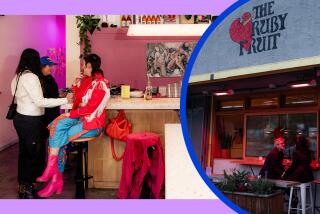Plastics People : They still seek the promise of airtight freshness and love to burp those lids. But in the ‘90s, the Tupperware Lady just may be a man, and vodka martinis may beat out punch at the party.
- Share via
Fresh from Middletown, USA, circa 1950, the Tupperware Lady swooped into the post-feminist ‘90s on a recent Friday night, hawking her stock to a co-ed crowd of Generation X-ers.
There they sat, a mix of yuppies and underemployed Ivy Leaguers, sipping vodka martinis, munching pigs in blankets and extolling the virtues of durable plastic.
Like their mothers before them, they played getting-to-know-you games, burped airtight lids and swapped quick-fix recipe ideas. One nostalgic woman kept humming the old Tupperware jingle:
We’re the Tupperware Ladies The Tupperware Ladies We’ll show you some new things A million and two things. . . .
After all, even Angst -ridden soul-searchers need to lock in freshness.
“When people mention Tupperware, it’s almost a joke--it seems like a joke,” admitted Dave Goetsch, 24, a would-be Tupperware Lady and sitcom writer who served as the party’s hostess.
“But at the same time, it’s very practical. This stuff has a lifetime guarantee. It’s never going to break, so it won’t get thrown out, it won’t contribute to the landfill crisis at all. Everybody has leftovers. You always need Tupperware, at whatever age,” Goetsch reasoned. “These goods connect us with a simpler time (but) to me, this is not something we’re revisiting. Tupperware continues.”
Goetsch, who organized the party and has even considered selling Tupperware to tide him over till he Makes It, began his love affair with the plastic products at 16.
That’s when his house counselor at a New England prep school made all the young men don blue blazers and invite dates to a Tupperware Party in the dorm. Later, as an undergraduate at Yale, Goetsch says he majored in Tupperware (although Yale preferred to call it American Studies) and threw a Tupperware Party of his own for folks in his seminar. So when he moved to Los Angeles hoping to break into the biz, Tupperware seemed a natural ice-breaker.
People laughed when he called with the invitation, and they laughed all through the party, but Goetsch takes this stuff seriously. After all, he studied it.
“Scholars have debated this for a long time,” he explained to the two dozen dubious party-goers in the chic Westwood living room that Friday. “The crux of the issue is whether Tupperware was a veiled social event with a commercial act underneath it--or, a more revisionist approach to Tupperware is that, under the guise of commercialism, it was a wonderful way to invite people into your home.
“There was no stress about Tupperware,” Goetsch said as the official Tupperware Lady he lined up for the night--Terry Cervantes--stood behind her brightly colored array of things to put other things into, eagerly waiting to start her shtick.
“It was this beautiful moment when people could come together. They knew what to wear. There was a reason.” (Last year, somewhere in the world, people found reasons to start Tupperware Parties every 2.7 seconds.)
*
For the last 18 months, Cervantes has done four or five of those parties a week around Southern California. She became a Tupperware Lady when she was laid off, after 17 years, as a banker. She had bought tons of Tupperware, so she figured she could sell it.
Lately, she has been spending a lot of time in the Valley, where earthquake victims are replacing glass and crystal with unbreakables. She’s done parties on college campuses, in hotels, for couples or singles, in English and in Spanish. Most are thrown by women, but a few--including her highest grossing, more than $1,000, and Goetsch’s, where guests spent $147.60--had men as the “hostesses.”
Along the way, she has picked up a few Tupper tips: Save scraps of celery and onions for stew and put wet newspaper inside containers to kill the smell.
She has also picked up a little information on parties: “They’re basically all the same. The people get excited. There’s always something everybody wants.”
At Goetsch’s party, it was the soda sealer, a plastic disc that saves the bubbles in a half-drunk can of pop. Or beer.
Now don’t look for this little lifesaver in the catalogue. It’s a party-gift-only item. Like the comb and the pillbox and the melon baller and the grapefruit spoon and the soap dish and the toothbrush holder and the mini-grater and the cookie cutter, you can’t buy the soda-sealer in stores, you can’t buy it from the catalogue and you can’t even buy it from Cervantes. You’ve simply got to get lucky.
Party-goers jot their name on several slips of paper and throw them into a Tupperware bowl. Cervantes picks a name, that person picks a gift. As the picking continues, people snatch prizes from each other, so those who pick last get the best picks.
The soda-sealer swapped hands so many times that someone finally sighed, “It’s only a matter of time before you lose the top.” Three guys fought it out viciously, but when the game ended, a woman named Alexis held the prize aloft, triumphant.
“What do you mean?” someone pleaded. “We can’t buy these caps?”
Cervantes shook her head.
“Yes,” Alexis called out, eyeing Cervantes and considering a career change. “You can!”
Tupperware Trivia
* Founded: 1945, by engineer Earl Tupper * Annual net sales: $1.2 billion * Where available: 56 countries, including Iceland, Monaco and Namibia * Annual sales outside United States: 80% * Number of Tupperware Ladies (including some men): Half million * American homes with Tupperware: 90% * Other places with Tupperware: Art museums in London and New York * Other Tupperware wares: toys, luggage, picture frames and gadgets, like a little sign that proclaims the dishwasher clean or dirty * First product: Bell Tumblers--which, to the Tupper-illiterate, are cups for kids. (Then: 39 cents a pair. Now: $4.40 for four.)
More to Read
Eat your way across L.A.
Get our weekly Tasting Notes newsletter for reviews, news and more.
You may occasionally receive promotional content from the Los Angeles Times.










